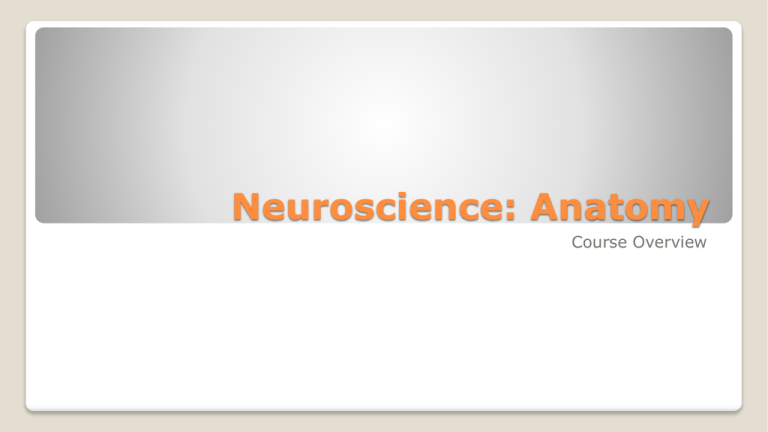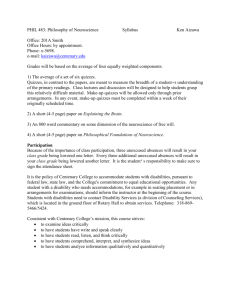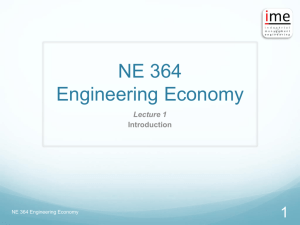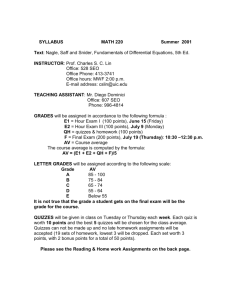1 Course Overview - 34-602-Neuroanatomy-SP15
advertisement

Neuroscience: Anatomy Course Overview Group 1 Nate Shaye Sarah C. Group 2 Erin P. Drew Kelcie Group 3 Corey Conor Alex Group 4 John Carolyn Amber Group 5 Mike Vickiey Jess Group 6 Kristen Andy Alicia Group 7 Sarah M. Kaela Diamond Group 8 Gennessa Chris Matt Group 9 Brett S. Krissy Joe Group 10 Erin C. Courtney Sean Group 11 Jake Annie Brett M. Lecture Teams Read the abstract. 2 minute small group discussion. Does this article challenge what you know about the brain? Reference the article in your discussion. Article – Alexia without Agraphia No need to record your thoughts 1. What kind of structure or organization does the brain have? 2. What is learning? 3. How many distinct sensations do humans perceive? 4. How does movement occur? Where do the signals originate? 5. What is consciousness? 6. What do you expect to learn in this course? Determining Pre-conceptions Discuss in groups of 3 for 10 minutes Spinal Cord Brainstem/ Cerebellum Sensory Pathways Overview and Development Other Pieces of the puzzle Cerebrum Cranial Nerves Organization of the Course Motor Pathways Lundy-Ekman, L., Fundamentals for Rehabilitation, 4th Ed. Elsevier. New York, NY, 2013. Bear, M., Connors, B. W., Paradiso, M. A. Neuroscience: Exploring the Brain, 3rd Ed. Lippincott Williams & Wilkins. Baltimore, 2007. Netter Textbooks Similar structure as Clinical Anatomy ◦ Clickers ◦ Completion of readings ◦ Schedule and Wiki page Lecture Expectations Split into two halves ◦ Neuroanatomy ◦ Neurophysiology/Neurology Neuroanatomy ◦ Term lists – models, real brains (no dissecting), images ◦ Unstructured time ◦ Quizzes – clicker, self-paced quizzes at the start of lab each week ONLY PREVIOUS LIST MATERIAL ◦ Wiki and schedule Lab Expectations Participation Quizzes Exams Literature Review 10% 10% each (3) 20% each (2) 20% Assessments Everyone starts at 100%, deductions will be made for all of the following: ◦ Clicker Questions – I will grade them this semester! (~100 questions throughout the semester = .01 points per question) ◦ Absences – email me ahead of time for excused absence (I will likely need to refer back to email chains when calculating this grade at the end) ◦ During class – I will be taking notes of any disruptions or lack of participation in class. Participation- 10% of grade 3 in-class quizzes Grades will be averaged to count for 30% Multiple choice only, 20 questions Quizzes – 30% of grade One Midterm One CUMULATIVE Final ◦ Information is so interdependent that it would be impossible to test the second half of content without the first half! Exams – 20% of grade EACH Formal Literature Review of a chosen topic Background, Introduction, Methods, Results, Discussion (change of wording is fine, it is the conceptual divisions that matter) Conduct research, analyze research Literature Review– 20% of grade Wiki page Sign ups for presentation dates ◦ Open Jan. 30th at 12pm ◦ Close Jan. 31st at midnight ◦ Email if you have any issues regarding sign ups Process will be guided Literature Review details Nature of Neuroscience Lecture Study Guides For Monday – read ch. 1 of Bear and Lundy-Ekman ◦ Monday we will discuss necessary concepts that will be used throughout the rest of the course Labs begin in Lab 203 Monday, Tuesday and Wednesday next week – bring Netter and/or Bear Open Lab with Carley will be Fridays 11-1 ◦ Key will be available until the week before the Tag Test Carley will be in the Resource center Thursdays 3:15-4:15 My Office Hours are M & W after class, Th 9-10am Final Notes Lecture structure? Lab structure? Literature Review? Questions



